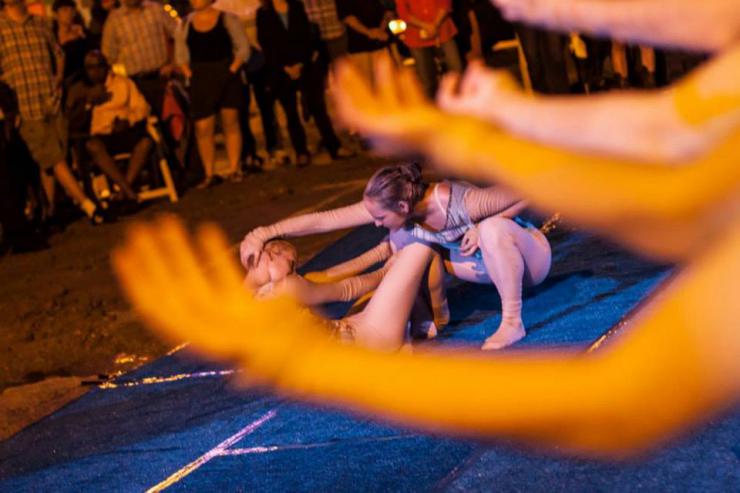Six Ways of Thinking about Liquid Culture
Atlanta can get hot this time of year, but for the past three summers, dancers in the Atlanta-based company gloATL have hit the streets and public spaces of the city for "Liquid Culture," a performance series held at various “utopia stations.”
Past Liquid Culture series have variously involved opera singers roving about a minimalist public art installation, a contemporary music ensemble playing at an intersection during rush-hour traffic, dances along store fronts and in window displays, and explorations in and about a sterile corporate live-work development above a transit station.

Sound Table in Liquid Culture, choreographed by Lauri Stallings.
Photo by Thom Baker.
Typically, the audience gathers slowly, eyes scanning and necks craning to spy the first performer, who usually quietly slips in from nowhere and whose physical presence and affect is sibylline. The beginning movement language is often uncertain, unfolding with small, promising brushwork but clipped from a larger and as-yet undisclosed pattern. Music comes in amid-gesture and during the performance spans from Romantic piano to textured soundscapes by Kaija Saariaho. This year, gloATL collaborated with playwright Pearl Cleage, who prepared brief snippets of text spoken by teen actors participating in the Alliance Theatre's summertime Collision Project. The youth often spoke just one sentence about aspirational, utopian themes or sentiments that were mic’ed in just under the music.
There are many ways to think about Liquid Culture—with multiple performances spread over two weeks, it's a vast work—but here are six ways that came to mind during this summer’s series.
- Performance is an act, but it's also an alibi, the perfect excuse for both performer and viewer to indulge in states of consciousness that are impermissible under almost any other social circumstances. The roots of Western theater lie in the ecstatic pagan rituals of the Greek cults of Dionysus. Performance is still, at its heart, more than any other art form, ecstatic, pagan, communal. Performance provides an opportunity for a sort of self-aware but selfless attentiveness to the lived moment.
For a performance, we must have momentary faith that reality is sustainable without our attention to it
- Performance requires not so much a suspension of disbelief, but an instatement of it. Marcel Proust wondered if the objects in our world might somehow get their solidity and stability from our conviction that they are solid and stable, as if immobility is, in fact, forced on them by the immobility of our conception of them. It's an intriguing thought, but a slightly disturbing one. (Certainly if objects were to depend on my powers of focus and attention for their stability, we're all in for some serious trouble.) Perhaps performance might be an opportunity to release some subconscious sense of responsibility, our innate sense of duty that we, who must surely be the center of everything, must also be in some way responsible for holding the universe together and keeping it in order. For a performance, we must have momentary faith that reality is sustainable without our attention to it: we permit ourselves to ease our focus for a bit and then return. Perhaps this release of conviction, not the attentiveness to it that Proust describes, is actually what allows us to keep our shit together. Art is the glue that keeps our world from dissolving into a blubbery mess.
- Performance can be utopian. The meaning of utopia can be dual, and rather than a beautiful place (eu-topia in Greek) it can also can mean no-place (ou-topia). At each utopia station, swings were hung for the audience to share and from which the performance could be watched, at least until dancers might make use of them. The swinging childlike pendulum movement thrills by its being ever potentially elsewhere than it is. More than once, adults tentatively approached the swings, gave them a try and left seemingly lighter in spirit. Movement along with the swing can lighten one's mood, perhaps allowing even a non-dancer to experience the thrill of the performer.
- Movement is more than just a spectacle. The utopian stations, set at intersections, had the effect of splitting dancers into clusters, while giving onlookers—including office workers and motorists—360-degree views. Sidewalks alongside and further from the intersections chopped or rather concentrated the movement language into snippets or phrases, and made it much like a catwalk for individual dancers and pedestrians passing by. Groupings of dancers where these snippets would develop further would often occur away from these foci. The dancers did not exhibit gendered characters, or any serial masculine and feminine archetypal movement: no males vie for a female partner, no backing away of other dancers for a focus on just one male and female couple, men are not lifting and jumping, women are not in sheepish groups or en pointe. No, the movement was more that of otherworldly aliens, animals perhaps but from another planet. Not grotesque, but neither simplistically beautiful either. The gaits were off, balance frequently off-centered, movement ploddingly slow without purpose, and purposefully quick without warning.
- Charged spaces seemingly unsuited to performance are often just waiting for someone to perform there. These utopia stations also were nearly all in charged spaces, and defined by being not exactly “public” in the traditional sense but overlooked. Atlanta is a city of trees, most of them in other people's back yards, and seemingly every public place gathers some rent. The first utopia station this year was on a blacktop vacant lot at the corner of the historically charged and gentrifying Fourth Ward, close to the Martin Luther King, Jr. historic district—birthplace of that great democratic vision. Another station was in a wee nowhere tract in the shadows of the Atlanta Federal Reserve, the capitalist spirit's guarantor whose very architecture, trees and shin-high landscaping were designed to prevent another Oklahoma City bombing. The last utopia station was in a plaza between the older modernist Woodruff Arts Center and the newer section of the High Museum, with its pristine white metallic fins and natural light-grabbing orbs designed by Lorenzo Piano. At the base of this particular station stands a copy of Auguste Rodin's, The Shade, a downcast figure of mourning the French government gave to Atlanta after so many of her art patrons died in a 1962 plane crash at Orly field in Paris while on a museum-sponsored trip.
- Performance can make the old new again, and the new old. The final performance ended with Leonard Cohen’s “Take this Waltz,” with the dancers dissolving into the audience, offering their elbows to take those willing back into the center for a last dance. By that time, evening had set in and the lighting was so low that any audience/performance divide was minimal, and those hanging along the sides just soaked in the atmosphere. The rumbling of thunder from an earlier front had faded. The waltz is a simple dance, but tempo, mood and music did so much to enliven it that it was a living, heady thing.









Comments
The article is just the start of the conversation—we want to know what you think about this subject, too! HowlRound is a space for knowledge-sharing, and we welcome spirited, thoughtful, and on-topic dialogue. Find our full comments policy here